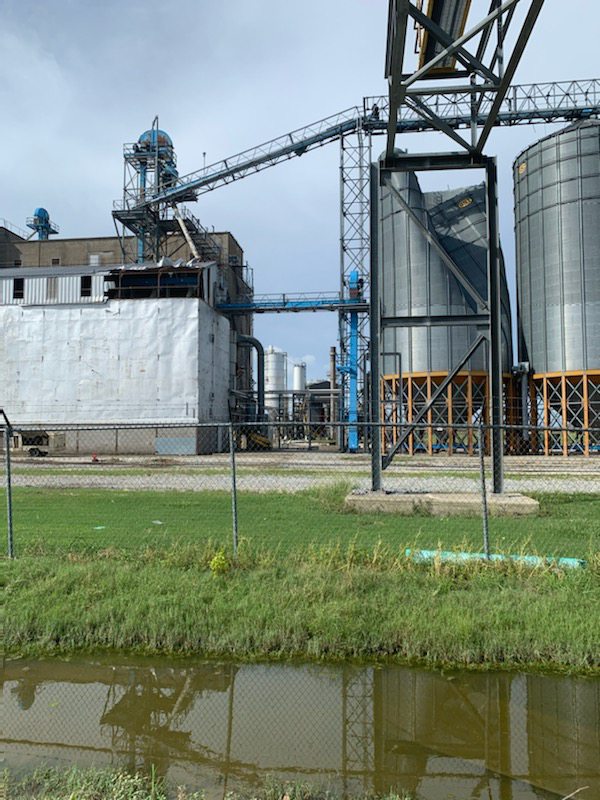 Laura's destructive winds tore through metal
Laura's destructive winds tore through metal
Sep 17, 2020
LAKE CHARLES, LA -- The effects on the rice industry following Hurricane Laura continue to be felt across the mid-South, and particularly in southwest Louisiana where some harvesting has resumed, and yields there are telling a before and after story.
With most of the rice crop in Louisiana’s southern region harvested at the time the storm hit on August 27, concerns here immediately switched to getting power to drying facilities to maintain the crop for quality. Some isolated areas are still on generator power, but until things return to a more “normal” state, concerns in the region continue to evolve through the transition from pre-storm to post-storm.
Lake Charles, ground zero for Laura’s landfall, plays an integral role in the processing and exportation of rice throughout the globe, and the Port of Lake Charles facilitates vessels of milled and paddy rice for exporting year-round.
“The Port of Lake Charles is open for business,” said Therrance Chretien, director of cargo and trade development for the Port of Lake Charles. “Fortunately, our automated terminal warehouse which is primarily used for handling bagged goods and commercial rice survived Laura with minimal damage. The Port, in the next few days, will be receiving rice and other cargo for a food aid shipment destined for Africa. We plan to accommodate any and all future rice shipments to support the local rice community during this recovery.”
Farmers Rice Mill, which has operated for more than 100 years just east of Lake Charles, sustained damages from Hurricane Laura, and they are working to repair the mill as quickly as possible to resume operations.
“We’re still digging ourselves out in many ways,” said Philip Bertrand, general manager of Farmers Rice Mill. “We’ve got crews working on just about every aspect of the facility, alongside our engineers and specialists who are evaluating the damages for both temporary and permanent repairs depending on priority.”
With power still out around Lake Charles, in Calcasieu and Cameron Parishes, and not expected to be restored until at least the end of the month, it’s difficult to know the timeframe for Farmers Rice Mill to be back in full operation. The next step in recovery for everyone in this area is rebuilding, and materials and supplies will become the next challenge to keep things moving forward.
“We’re committed to supporting our customers and the farmers of southwest Louisiana, and will continue to do so through all this,” said Bertrand. “The outreach and support from the U.S. rice industry has been overwhelmingly positive and greatly appreciated over these past few weeks. Like so many in this area, we’ve got a lot of work to do, but you start seeing a little progress every day.”
Mills in Crowley and Mer Rouge experienced some interruptions, but because they were not in Laura’s direct path, they are further along in resuming normal operations.
“Crowley was about 15 to 20 miles east of the devastating winds of the storm and I consider us very lucky,” said Robbie Trahan of Falcon Rice Mill. “Our facility here did not sustain any major damage and we were back up and running in two days.”
“We sustained some damage here in the Crowley area, but thankfully it was minimal,” said Bobby Hanks, CEO of Supreme Rice. “Prior to the storm, we were moving combines to many growers in the southwest region to get the crop out of harm’s way. After the storm, our efforts have focused on helping those in need to move and dry rice that was harvested. In anticipation of losing power we secured 13 large generators to assist in moving and drying rice. They came in handy as we had to deploy many of those generators to farmers and driers across the state who lost power. A lot of storage bins were compromised and without power, with rice that needed to have air moving on it, so we’ve been working with farmers to save as much of the crop as we can.”
According to Meryl Kennedy, president of Kennedy Rice Mill, located in the northeast corner of the state, their facility was “thankfully largely unaffected considering the extensive damage that many of our employees, family, and friends suffered in our area. Because of the hurricane-force winds, we believe there was severe damage to approximately 2-3,000 acres that were at a peak point of pollination at the time of the storm. Our hearts and prayers go out to our friends in south Louisiana, particularly in the Lake Charles area.”
In the field, harvest is getting underway in northeast Louisiana and Arkansas, where damage to downed and wind-battered rice from Laura’s persistent hurricane-force blasts are still being determined.
“The high winds have blown corn, soybeans, and rice on the ground in most of the fields here in Morehouse Parish causing a lot slower harvest,” said Jason Waller, a rice farmer from Mer Rouge. “The harvest is just more expensive when you have to pick it up off the ground!”
Time will tell the full extent of damage to the 2020 rice crop. It will be months before the full calculation of how much, and what impact each aspect of the industry sustained.